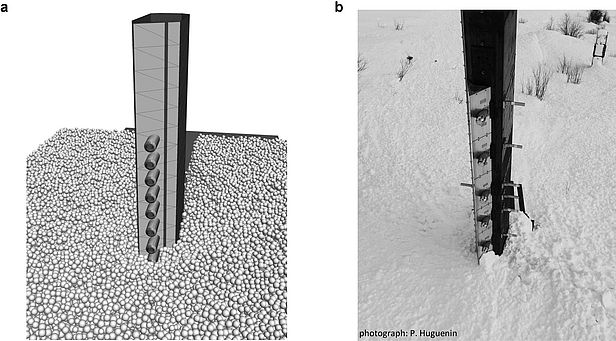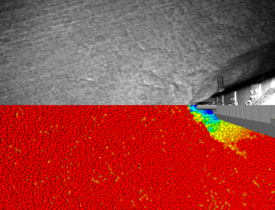14.03.2022 | Roman Oester | News SLF
How much pressure avalanches can exert on obstacles such as houses or cable car pylons has been a perennial question for avalanche researchers. The WSL Institute for Snow and Avalanche Research (SLF) has now developed a new calculation method that considers different flow types and tallies well with measurements. It is likely to prove a useful practical tool for those designing avalanche protection measures in the future.
Ever since avalanche research began, scientists have been investigating the pressure that avalanches exert on obstacles. Until now, calculations have been based on models. While these accurately represent fast, dense flow avalanches, they can underestimate the pressure from slow-flowing wet snow avalanches. However, in practical applications – designing suitable protective measures for buildings, for example – it is important to consider a range of avalanche flow types. SLF researchers therefore set about investigating the processes that occur in the interaction between obstacles and avalanches with different flow types, and have developed a new method for calculating avalanche pressure on obstacles. To do this, they had to consider a range of factors influencing avalanche pressure, such as the avalanche's behaviour during the flow process and the cohesion of the avalanche snow. With the new method it should now be possible to determine pressure values more precisely.

Computer simulations
The physical processes involved in the interaction between avalanches and obstacles were investigated using the discrete element method (DEM). An avalanche is modelled as a granular flow that has very different flow properties depending on its composition and temperature. A slow-moving wet snow avalanche builds up more pressure near the ground than at the surface because the pressure depends on the weight of the snow above. Furthermore, avalanche pressure increases proportionally to the square of the velocity, which is a particularly relevant factor in faster avalanches. The researchers used computer simulations to model collisions between numerous virtual avalanches and obstacles of different shapes. From these simulations they derived pressure calculation methods, which they then compared with measurements from real-life avalanches hitting obstacles.

Promising results

The researchers were able to draw on a large data set from the SLF's Vallée de la Sionne avalanche test site in Arbaz, canton of Valais. The site's numerous measuring instruments, installed on various structures, have been recording a range of avalanche parameters for over 20 years. For example, equipment including pressure sensors, a high-speed camera and velocity sensors is set up on a 20-metre-high pylon, and there are two differently-shaped wedges providing further data on avalanche pressure. The highest measured impact pressures are around 1,200 kPa (equivalent to 120 t/m2). Comparisons between simulated and real avalanches show that the new calculation method reproduces the measurements well. However, further research is needed before the method can be put to practical use.
Testing suitability for practical application
The objects on the avalanche slope at the test site in Valais are slender. However, to calculate the impact of an avalanche on a wider structure such as a house wall, more experiments with larger obstacles are needed. The previous research has laid the foundations for this. In the future, the new calculation method could also be used to update existing standards and improve the design of protective measures, thereby enhancing avalanche safety. In any case, there is definitely a need among experts for more precise methods of calculating avalanche pressure.
Contact
Publications
Links
Copyright
WSL and SLF provide the artwork for imaging of press articles relating to this media release for free. Transferring and saving the images in image databases and saving of images by third parties is not allowed.